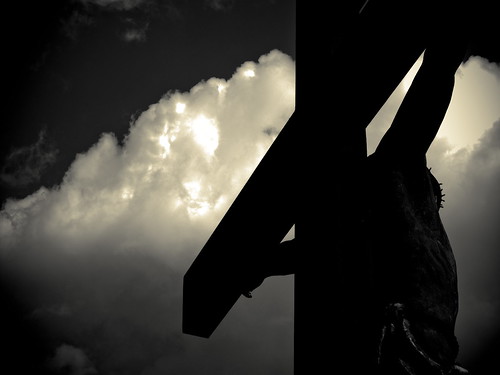We run our website the way we wished the whole internet worked: we provide high quality original content with no ads. We are funded solely by your direct support. Please consider supporting this project.
How NOT to be Christ-Centered: A Review of God With Us – Part III
In the previous two posts on Oliphint’s God With Us, we’ve seen that Oliphint is trying to reframe divine accommodations in a Christ-centered way, but that what he means by this is not that he is going to derive his understanding of God from Christ, but that he is going to use the “hypostatic union” articulated at the Council of Chalcedon as his framework.
Oliphint is admirably forthright in acknowledging the paradoxical nature of the Chalcedonian Christology, as he interprets it. In becoming human while retaining all of God’s essential properties, Oliphint admits that, “the Son of God partakes of two different and seemingly incommensurable kinds of properties” (206). So too, when God became a human while retaining all his essential attributes, he created an “antiomic situation” that inevitable results in “a paradox.” Hence, “any proper attempt at explaining that union will result in paradox” (209).
Indeed, Oliphint several times seems to concede that this Christology is – or at least inevitably appears to be –blatantly contradictory. For example, Oliphint at one point concedes the objection of Thomas Morris concerning the contradictory properties ascribed to one person in the Chalcedonian confession.
That two contradictory properties can reside in one person does not thereby remove the contradiction…just because the two are one does not automatically mean that we can articulate that ”oneness” in an intellectually satisfying way. Thus, because it is one person who has these conflicting properties, it makes it difficult for us to describe his character without quickly reaching our intellectual boundaries (205).
Not only does Oliphint concede that this interpretation of the Chalcedonian Christology is apparently contradictory, but his central strategy for understanding divine accommodations involves turning this “antinomic situation” to his advantage. He does this by using this mysterious hypostatic union as the paradigm for understanding how a wholly independent, atemporal, immutable and impassible God can appear so different in Scripture. Indeed, this is precisely what Oliphint means when he claims to have a Christ-centered understanding of accommodation. “[T]he Chaleconian Creed,” he says, “gives us substantial and significant precedent in which we can accept and affirm that there is a mysterious harmony in [God’s] attributes” as he condescends to interact with his people (205).
Hence, just as God condescended in Christ to take on human attributes without setting aside his essential divine attributes, so too God has throughout history condescended to take on the attributes of his creation as a means of relating to, and revealing himself to, his people. Oliphint essentially applies the “reduplicating strategy” (“X as A is N”), mentioned in Part I, to the whole Bible. As God is in himself, God is wholly independent, pure act, immutable, impassible, etc. As God is in his covenantal activity, however, God can be responsive, change his mind, be influenced by others, experience passions and even acquire information over time (192-94 ).
And here’s where things begin to get interesting (finally, some may be thinking). The most important implication of Oliphint’s Chalcedonian reframing of God’s condescending activity is that it allows him to affirm that the “covenantal attributes” that God acquires as he condescends to relate to humans are real – as real as the humanity that God assumed in Christ. “[God] both is immutable and in his condescension takes on covenantal properties in order really and truly to relate himself to us.” (191). This means that Oliphint doesn’t have to explain passages that depict God experiencing emotion, changing his mind or acquiring information through time by saying they are merely anthropomorphic or phenomenological descriptions, as the classical tradition has typically done. Indeed, Oliphint sides with Open Theists who have, in his view, effectively exposed the weakness of these explanations (183-94, 219-19).
Oliphint rather argues that, “God really does take these properties” (219). Hence, God literally changes his mind (op.cit.) “[T]he God who is immutable and whose plan and purposes for creation and his people will not fail can and does relent” (186). In his view, any explanation of these depictions of God that denies their literal reality “fails to recognize that what God has done in Christ through condescension he has been doing from the dawn of time” (191-92). As God literally became a human in Christ while retaining his essential properties, so too God literally takes on all the properties ascribed to him in Scripture as he condescends to relate to his people.
If one questions how a God who cannot be affected by anything outside himself can nevertheless really be affected by things outside himself and can really be responsive, or if one wonders how a God who is pure act and thus has no potential for change can nevertheless really become something he was not before (the Incarnation) and can nevertheless really change his mind, Oliphint simply points them back to the mystery of the (his interpretation of) the Chalcedonian Christology. In the end, Oliphint concedes that this conception of God is “shrouded in mystery” (226) as he encourages us to “get used to the idea that antimony and paradox will inevitably surround discussions such as this…” (225).
So, what should we make of all this? I will offer my response in the fourth and final segment of this review.
Category: Essays
Tags: Book Reviews, Classical Theism, Cruciform Theology, Essay, God With Us
Topics: Biblical Interpretation
Related Reading

Getting Behind the “Letter” of Violent Portraits of God
“I will do to you what I have never done before… in your midst parents will eat their children, and children will eat their parents…” Ezek. 5:9-10 In my previous post I offered a brief review of Matthew Bates’ fascinating work, The Hermeneutics of the Apostolic Proclamation by Matthew Bates (Baylor University Press, 2012). Among other…

Jesus Repudiates OT Commands on Oath-Taking: A Response to Paul Copan (#9)
In his critique of Crucifixion of the Warrior God (CWG), Paul Copan argues that “Boyd pushes too hard to make Jesus’ teaching appear more revolutionary than it really is” [italics original]. Whereas I argue that Jesus repudiates aspects of the Old Testament (OT), Copan argues that Jesus merely repudiates wrong applications of the OT, not…

One Word
While I’ve lately been pretty distracted finishing up Benefit of the Doubt (Baker, 2013), my goal is to sprinkle in posts that comment on the distinctive commitments of ReKnew a couple of times a week. I’m presently sharing some thoughts on the second conviction of ReKnew, which is that Jesus Christ is the full and…

A Coming Storm
There is a storm beginning to brew on the horizon. It is a debate among Evangelicals about the violent depictions of God, stirred up largely by Eric Seibert’s Disturbing Divine Behavior. Here is a post that sounds “the clarion call.” The debate is presently around two options. Option #1: Traditionalists argue we must simply embrace…

Revolting Beauty
In this sermon clip, Greg shares the story of how foster parents entered into the pain of a severely abused child and demonstrated compassion rather than judgment when she displayed puzzling and revolting behaviors. This moving story illustrates the way that God enters into our sin and our curse on the cross, and gives us…

Quotes to Chew On: The Cross and God’s Love
“The cross is the central way Christ images God. Christ was not an innocent third party who was punished against his will to appease the Father’s wrath. Christ is himself God, and he voluntarily took our sin and its just punishment upon himself. Hence his sacrifice does not appease God’s wrath; it reveals God’s love.…

